The Reduction of aCarbonyl with Sodium Borohydride
Sodium (or potassium) borohydride is a highly selective reagent that reduces aldehydes or ketones to the corresponding alcohols but normally does not reduce nitro, nitrile, olefinic, amide, carboxylic acid, or ester functional groups. The reagent is less reactive (i.e., more selective) than lithium aluminum hydride. Moreover, it may be used in aqueous or alcoholic solutions. Lithium aluminum hydride, on the other hand, reacts violently with such hydroxylic compounds and must be used in inert solvents such as ether, tetrahydrofuran, etc. In this experiment a simple example of the use of sodium borohydride is illustrated by the reduction of benzophenone (diphenyl ketone) to diphenylmethanol (diphenylcarbinol).
Equation:
(1) 4 C6H5-(C=O)-C6H5 + NaBH4 6 4 [(C6H5)2CHO-]-BNa
Benzophenone
(2) 4 [(C6H5)2CHO-]BNa
+ 4 CH3OH 6 4 [(C6H5)2CHOH]
+(CH3O)4B- Na +
diphenylmethanol
Table of Physical
Constants
| Compound | M.W. | Density | mp | bp |
| C6H5COC6H5 | 183.0 | ----- | 47 | 305 |
| NaBH4 | 37.83 | ----- | ----- | ----- |
| C6H5CH(OH)C6H5 | 184.0 | ----- | 66 | 297 |
Tabled Amounts of Reactants
Used and Amounts of Products Theoretically Possible
|
|
C6H5COC6H5 |
NaBH4 |
H2O |
C6H5CH(OH)C6H5 |
CH3OH |
|
|
|
MW |
182.2 |
37.83 |
18 |
184.2 |
28 |
|
|
|
Moles |
|
|
|
|
|
|
|
|
Grams |
1 |
0.25 |
|
|
|
|
|
|
ml |
|
|
|
|
|
|
|
Procedure
1. Dissolve 1 g of benzophenone in 7.5 ml of methanol in a 50‑ml Erlenmeyer flask.
2. In a 5 or 10 mL beaker add 0.25 g of sodium borohydride.
3. Add the sodium borohydride in small portions and with swirling to the benzophenone solution at such a rate that the temperature does not exceed 45oC. The reaction is exothermic and the rate of addition, therefore, should not be too rapid.
4. After all the sodium borohydride has been added, heat the reaction to boiling for 2 minutes. Add the hot solution to a 50 mL beaker half full of ice.
5. Allow the ice to melt and collect the diphenylmethanol on a small Buchner funnel.
6. Wash the crystal cake twice with 25‑ml portions of water and allow to dry overnight.
7. At the beginning of the next lab period, weigh the product, and determine its melting point. Yield about 1 g (95%). Include in your notebook and in your Lab Report, also calculate the % yield.
8. Use this product in the alcohol classification assignment.
Explanation of the Procedure
STEP 1 Sodium borohydride reacts with water to form H2 gas so, instead of weighing, which exposes the reducing agent to the water in the air for a significant length of time, you quickly dump a rounded teaspoonful into the methanol. The reaction with water is
H2O + Na+BH4- ---> Na+(BH3OH)- + H2 (gas)
STEPS 2 & 3 The reaction between sodium borohydride and benzophenone is kept below 50oC to minimize the side reaction of sodium borohydride with the solvent methanol. The side reaction is
CH3OH + Na+BH4- ----> (CH3OBH3)-Na+ + H2
and can go to (CH3O)4B-Na+ + 4H2 if all of the NaBH4 reacts with the solvent.
The mechanism of the main reaction involves hydride, H-, leaving NaBH4 + going to the benzophenone, see pg 496 of lab text.
The mechanism is

which is the white gum produced in equation (1) shown at the beginning of the experiment.
STEP 4 The
borohydride salt of diphenylmethanol is hydrolyzed in two steps by the aqueous
HCl. Reaction (a) is
